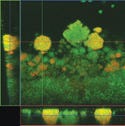Diagnostic Test Detects Harmful Biofilms
October 1, 2007
R&D DIGEST
|
Researchers Jeff Leid and Tim Vail demonstrate their rapid diagnostic test for nosocomial infections. |
An innovative diagnostic test identifies the presence of biofilms in patients that resist treatment. One application is to test for hospital-acquired infections. By detecting the films that indicate a staphylococcus aureus (staph) infection, the assay seeks to help doctors treat patients quickly and effectively.
Called the lateral flow assay, the portable low-cost test makes a diagnosis in less than 10 minutes. It could be used in rural areas where advanced diagnostic equipment isn't widely available.
“There are currently no diagnostic tools in the United States specifically for detecting biofilm infections in humans,” says Jeff Leid, PhD, associate professor at Northern Arizona University (NAU; Flagstaff). The Centers for Disease Control estimates that biofilms cause more than 70% of nosocomial infections.
Biofilms attach to tissue and bones as well as to implants such as catheters and heart valves. The problem is that the organisms resist antibiotics and prevent the immune system from treating infections, which can cause chronic problems in patients.
|
The lateral flow assay reveals bacterial growth in the form of biofilms. The test takes less than 10 minutes. |
A team of researchers at NAU and the University of Maryland (Baltimore) developed the patent-pending device, which is similar to the rapid test used by clinicians to diagnose strep throat. The assay has an absorbent strip with both a control line that ensures the device is working properly and a test line. It identifies biofilm-specific antibodies in patient serum, which then bind to biofilm-specific proteins on the device. A positive read on the test line indicates a staph biofilm infection. The device makes it easy to interpret the results and does not require clinicians to receive additional training.
Manufacturers of implants could also use the device during product development testing. “This device would provide an easy way to test for the presence of bacterial biofilms on prototype devices during the initial testing phases,” says Leid, who is also the associate director of NAU's Center for Microbial Genetics and Genomics.
Currently, the research team doesn't envision any essential changes to the device. Leid thinks that if a company decides to license it, the final product will complement other technologies of the particular manufacturer.
“The next step for the group is to continue to look at novel diagnostic tools [and treatments] for biofilm infections and hopefully get this device on the market so that physicians and clinicians have the appropriate tools they need to most effectively treat the patients they see,” says Leid. Early diagnosis of these infections could provide a greater chance for clinical treatments to work, dramatically improving patient health.
The other inventors of the test include Tim Vail, PhD, associate professor of biochemistry at NAU, and biology graduate student Jennifer Kofonow. University of Maryland researchers Mark Shirtliff, PhD, assistant professor of biomedical sciences, and biomedical sciences graduate student Rebecca Brady discovered the biofilm-specific proteins that were used to develop the assay.
Copyright ©2007 Medical Device & Diagnostic Industry
About the Author(s)
You May Also Like




